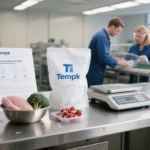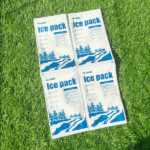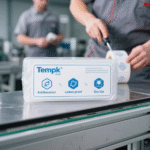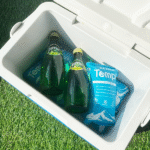Packs de glace sec contre gel: Qui est la meilleure solution de refroidissement pour l'expédition de la chaîne du froid?
Choisir la bonne solution de refroidissement pour l'expédition de la chaîne du froid est essentielle pour assurer la sécurité et l'efficacité des produits. Glace sèche et packs de gel sont deux choix courants, chacun offrant des avantages uniques. Mais ce qui est mieux pour vos besoins d'expédition spécifiques? Dans cet article, Nous allons explorer leurs différences, avantages, et utiliser des cas pour vous aider à prendre une décision éclairée.
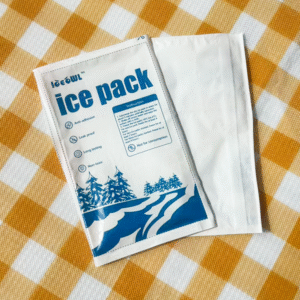
-
Quelles sont les principales différences entre les packs de glace sec et de gel?
-
Quand devriez-vous choisir de la glace sèche pour l'expédition de la chaîne froide?
-
Quels sont les avantages de l'utilisation de packs de gel sur la glace sèche?
-
Quels produits conviennent le mieux aux packs de glace sèche et de gel?
Quelle est la différence entre Packs de glace sèche et de gel?
Glace sèche est la forme solide de dioxyde de carbone (Co₂), sublimer directement d'un solide à un gaz à des températures extrêmement basses de -78,5 ° C (-109.3°F). Cette propriété le rend idéal pour les expéditions de longue durée qui nécessitent des températures ultra-bas.
En revanche, packs de gel sont remplis d'une substance gel non toxique qui gèle à des températures juste en dessous de 0 ° C (32°F). Bien que efficace pour le refroidissement à court terme, Les packs de gel sont moins adaptés pour maintenir des températures de congélation profonde.
Différences clés:
| Fonctionnalité | Glace sèche | Packs de gel |
|---|---|---|
| Plage de température | En dessous de -78,5 ° C | Au-dessus de 0 ° C |
| Durée de refroidissement | Jusqu'à 72 heures | Jusqu'à 24 heures |
| Réutilisabilité | À usage unique | Réutilisable |
| Problèmes d'humidité | Aucun (sublimer le gaz) | Humidité potentielle de la fusion |
Quand devriez-vous utiliser de la glace sèche?
La glace sèche est parfaite quand congelant est requis. Il maintient températures extrêmement basses, le rendre idéal pour biotechnologie, médicaments, et aliments surgelés.
Meilleurs cas d'utilisation pour la glace sèche:
-
Médicaments & Biotechnologie: Vaccins, échantillons biologiques, et certaines fournitures médicales nécessitent des températures sous-zéro cohérentes pendant le transit.
-
Aliments surgelés: La glace sèche assure des articles congelés comme la viande, fruit de mer, et la crème glacée maintiennent leurs températures requises tout au long du transit.
Exemple: Une entreprise pharmaceutique expédiant des vaccins vitaux de sauvegarde s'appuyera sur la glace sèche pour maintenir l'état gelé nécessaire pour jusqu'à 72 heures.
Quand devriez-vous choisir des packs de gel?
Les packs de gel sont mieux adaptés à Produits modérés et sensibles à la température. Bien qu'ils n'offrent pas de capacités de congélation, Ils sont parfaits pour garder les produits au frais pendant les expéditions courtes à moyennes.
Meilleurs cas d'utilisation pour les packs de gel:
-
Produits frais: Des articles comme les fruits et les légumes, qui n'a besoin que de rester frais et non gelé.
-
Produits de beauté & Produits de beauté: De nombreux produits cosmétiques doivent rester au frais, mais pas gelé. Les packs de gel sont idéaux en raison de leur polyvalence et de leur facilité d'utilisation.
Exemple: Une marque Skincare Shipping Beauty Products préférera Gel Packs, Comme ils ont seulement besoin de rester cool, pas gelé.
Packs de glace sec contre gel: Ce qui est plus rentable?
Alors que glace carbonique Fournit un refroidissement supérieur, Son coût et ses exigences de manipulation spéciales le rendent moins abordable pour certaines expéditions. D'autre part, packs de gel sont plus économiques et plus simples à gérer, en particulier pour expéditions plus courtes.
| Fonctionnalité | Glace sèche | Packs de gel |
|---|---|---|
| Coût | Plus haut | Inférieur |
| Gérer la complexité | Haut (nécessite des gants, ventilation) | Faible (sûr pour la manipulation générale) |
| Durée de refroidissement | Long (jusqu'à 72 heures) | Court (jusqu'à 24 heures) |
Comment choisir la bonne solution de refroidissement?
Le choix entre les packs de glace sec et de gel dépend des facteurs suivants:
-
Exigences de température: Si votre envoi doit rester en dessous de -18 ° C (0°F), La glace sèche est essentielle. Pour les produits qui ont besoin de rester cool (pas gelé), Les packs de gel fonctionnent mieux.
-
Durée d'expédition: Les expéditions plus longues nécessitent de la glace sèche, tandis que les packs de gel sont suffisants pour des voyages de courte durée.
-
Budget: Pour des solutions rentables, surtout lorsque les températures n'ont pas besoin de plonger en dessous du gel, Les packs de gel sont idéaux.
-
Considérations de sécurité: Les packs de gel sont plus faciles et plus sûrs à manipuler, les rendre adaptés aux biens de consommation.
2025 Tendances de l'expédition de la chaîne du froid
Durabilité devient un moteur de la logistique de la chaîne du froid. Packs de gel, Être réutilisable et plus respectueux de l'environnement, gagnent en popularité alors que les entreprises cherchent à minimiser l'impact environnemental. En plus, avancées emballage intelligent et Technologies de surveillance de la température Améliorera l'efficacité de la chaîne du froid.
Tendances à regarder:
-
Solutions durables: La montée des méthodes de refroidissement recyclables et biodégradables façonne l'avenir de la logistique de la chaîne du froid.
-
Emballage intelligent: Les capteurs RFID et le suivi de la température compatible IoT deviendront plus répandus pour assurer l'intégrité des expéditions sensibles à la température.
-
Automatisation et AI: L'automatisation dans les systèmes de routage et de gestion de la température axés sur l'IA améliorera encore l'efficacité de la logistique.
Questions fréquemment posées
Q1: Combien de temps dure la glace sèche par rapport aux packs de gel?
La glace sèche peut durer jusqu'à 5 jours, en fonction de la taille et de l'isolation. Les packs de gel durent généralement entre 12 à 48 heures, en fonction de la taille et des conditions environnementales.
Q2: Les packs de gel peuvent-ils être réutilisés plusieurs fois?
Oui, Les packs de gel sont réutilisables et peuvent être raffinés pour plusieurs utilisations, En faire une option économique.
Conclusion
Choisir la bonne solution de refroidissement pour votre envoi de chaîne froide dépend de vos besoins spécifiques. Glace sèche est parfait pour longtemps, expéditions ultra-froides, alors que packs de gel Fournir une option plus économique et plus facile à manipuler pour des expéditions plus courtes. En évaluant vos exigences de température, durée d'expédition, et le budget, Vous pouvez sélectionner la meilleure option pour vos marchandises.
À propos du tempk
À Rotation, Nous nous spécialisons dans la fourniture Solutions de chaîne froide sur mesure, offrant des deux glace carbonique et packs de gel Pour différents besoins d'expédition. Nos produits garantissent que vos marchandises restent à la température parfaite tout au long du voyage, Minimiser les risques et maximiser l'efficacité.
Pour des conseils d'experts sur vos besoins d'expédition à la chaîne froide, N'hésitez pas à Contactez-nous aujourd'hui!

















